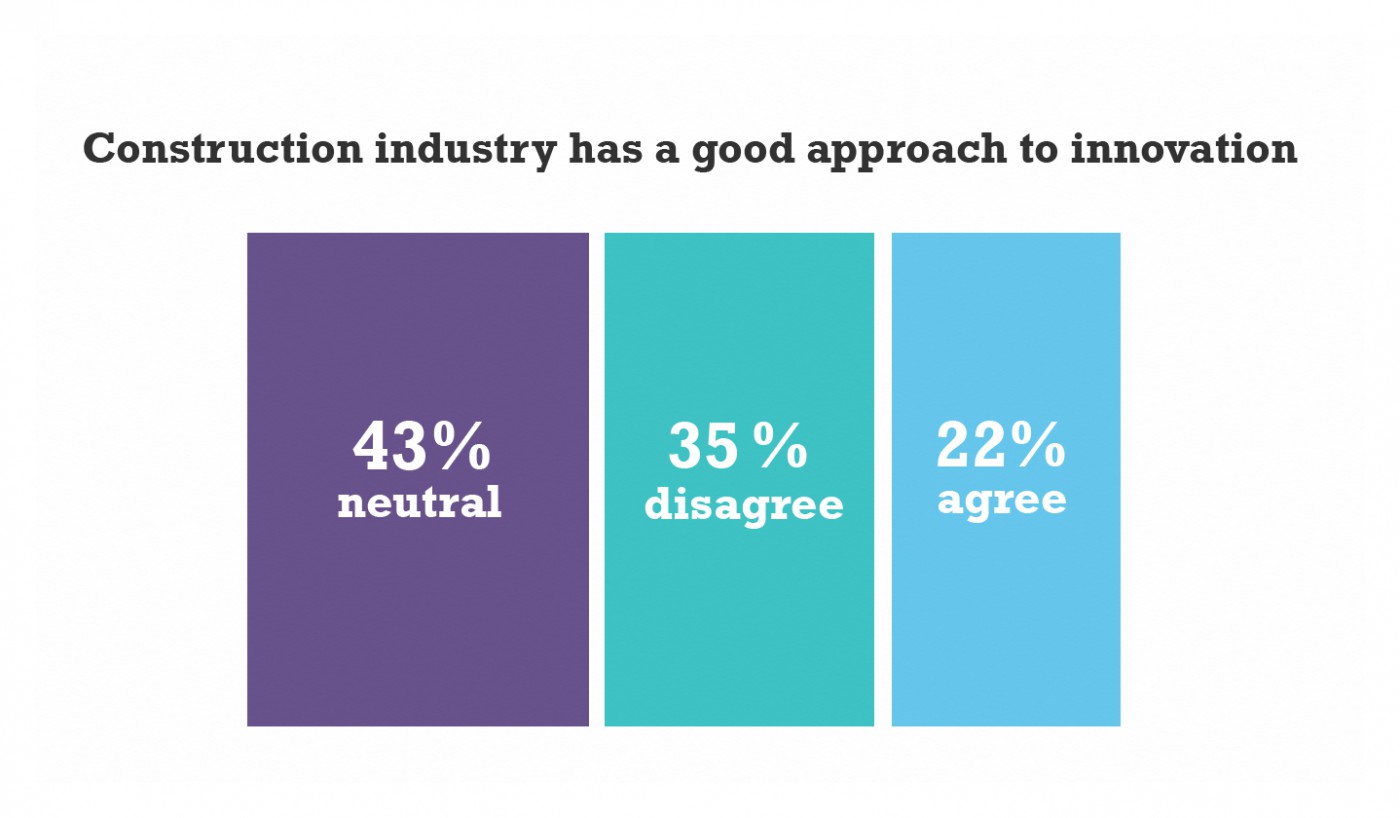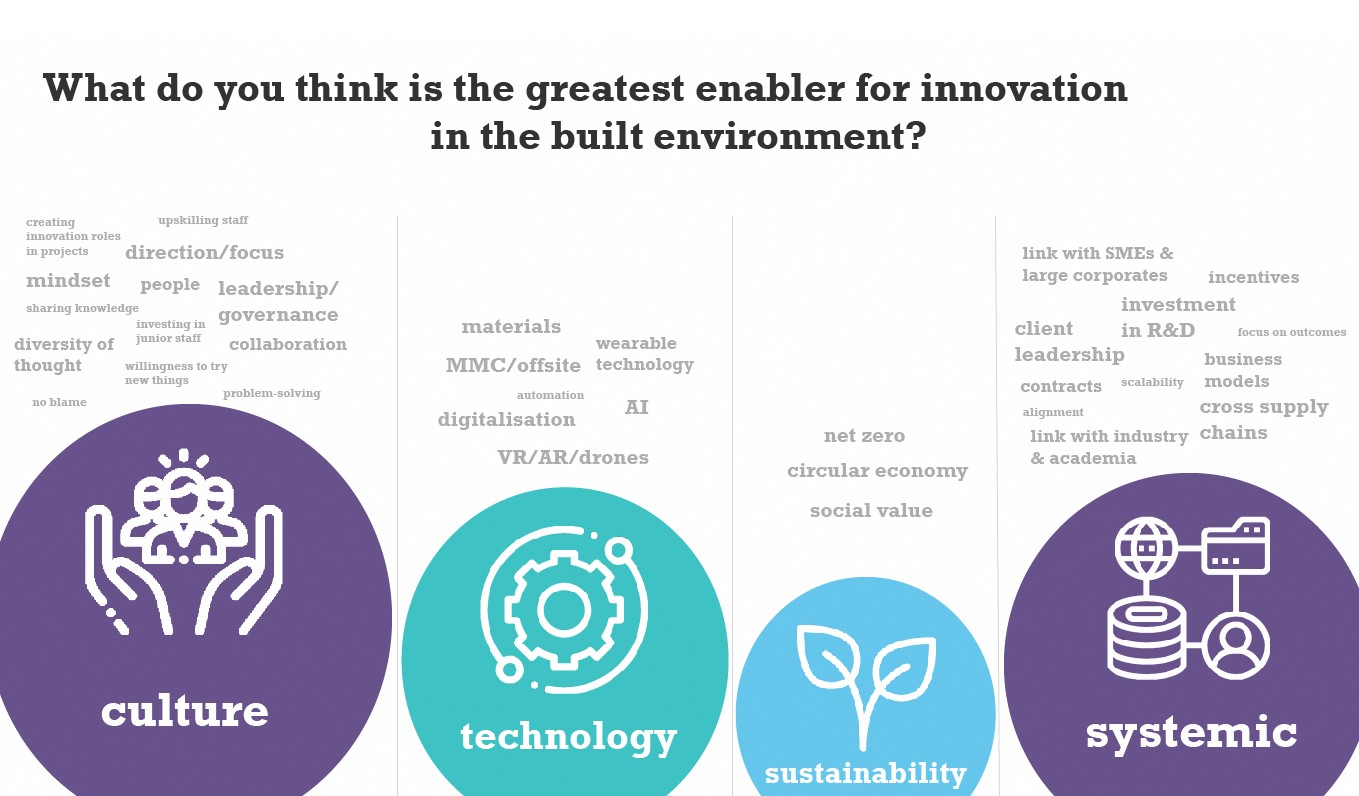Creating an Innovation Culture
“Construction is the most insanely exciting sector to work in at the moment!” This was the opening line of our recent Members Forum on Creating an Innovation Culture. This sector has always been innovative. It pushes boundaries, breaks records -the tallest, the longest, the quickest, the fastest!
We have asked our audience prior to the event how innovative they think the construction industry is. These are their opinions:

Our panellists represented a wide range of perspectives – Julie Barry (Rift R&D), Ben Fenwick (Arcadis), Dr Steven Yeomans (Construction Innovation Hub), Prof Chris Goodier (Loughborough University) and Dr Oliver Jones (Ryder Architecture). The discussion was chaired by Alison Nicholl (Constructing Excellence).
Perception is a huge issue holding back our confidence in our ability to innovate. Is there really any commonality between a jobbing builder and those that construct engineering projects like the Shard, Crossrail, HS2? Even our delegates have a poor perception of our approach to innovation, with less than a quarter believing the industry’s approach is good. With innovation happening at an unprecedented rate in every aspect from procurement (Value Toolkit) through materials (Mycelium houses) and everywhere in between, our panellists certainly set them straight on that!
Deliberate versus accidental innovation
Julie Barry is relatively new to the construction sector and believes that innovation is divided into two categories:
-
-
- deliberate innovation – companies/individuals wanting to do something completely different and bring something new to the market;
- accidental innovation – the innovation that happens to stumble across an innovative solution as a result of how challenging is what they are trying to achieve.
-
We tend to recognise just deliberate innovation, with accidental innovation perceived as less valuable, and this mindset needs to change. In Julie’s words, “It is amazing how many businesses we speak with that have stumbled across something that grows into a massive impact into the industry. And that discovery happened because they could no longer do things the way they used to.” Dr Oliver Jones believes there is a broad spectrum of innovation in the construction industry. From innovation done at a large scale to the innovation happening in smaller projects, such as unique problem-solving.
Is everyone an innovator?
Is innovation always evident? Do the workforce understands when they are carrying out innovation. Organisations need to recognise, reward, share and encourage innovation, whether it is deliberate or accidental. Recognition is critical to help the workforce understand the crucial role they play and that even small steps are powerful.
Collaboration is key
Dr Steven Yeomans emphasised that the most effective innovation will occur with organisations that can commit and are prepared to change. But that does not imply the rest are being left behind. The idea is for those ready for innovation to collaborate and align with each other. This will create a ‘butterfly’ effect that will positively influence the rest. We need to stop working in silos and share our progress and knowledge to accelerate the rate and pace of transformation.
Empowering young minds
Empowering young people often appeared as a core pillar to enabling an innovation culture.
The responsibility of leaders is to provide the environment and resources that nurture young people to bring their ideas to the table. Ben shared how his employer, Arcadis, has set up a ‘graduate solution scheme’ in which young people are encouraged to identify issues within the company and work together to come up with solutions. The scheme aims to encourage graduates To think freely and challenge pre-conceived ideas. Merging their brilliant ideas with technology might be the route to accelerated innovation.
From an academic perspective, Professor Chris Goodier identifies that one of the challenges is construction industry’s approach of moving from project to project, which can interfere with capturing that ongoing innovation and incremental learning. The role of academia is to teach students about innovation and help them with the tools to cultivate the innovator within them. When graduates enter different projects, their way of thinking challenges others. As Professor Chris Goodier puts it, “It is the younger minds that are not weighted down by years of doing things a certain way.”
Chris suggests it might occasionally might be worth taking a step back and allowing some space in between the projects to explore how they can cultivate innovation within their practice – organising workshops with the young professionals, accessing knowledge sharing from other sectors, apply some constructive constraints etc. Professions have a significant role to play in encouraging innovation and encouraging new entrants to focus on outcomes. Enabling young professionals to collaborate across disciplines and ultimately deliver better, more innovative outcomes.
How do we compare with other sectors?
Even if the sector is powering through innovation, there is still some way to catch up with other sectors such as banking or tech. As one panellist described it, the tech world is like a racehorse compared to us. However, as a laggard in the world of innovation we have a huge opportunity to embrace and collaborate with those outside the sector. For example, AgriTech, the new face of modern-day agriculture, did not emerge from the agriculture world. It actually came from a collaboration between agriculture and technology companies. We need to ask ourselves if we are making enough of other people’s investments.
Necessity is the mother of invention
Constraint is an essential element that pushes companies and individuals to find different, better ways of dealing with the challenges they encounter. These challenges create the conditions for innovation to emerge. For example, in the current drive, Net Zero, we face a huge challenge, where failing to meet the targets is not an option. However, if we do not allow a window for failure, we will not be able to create the culture for innovation. As Tom Kelly once said, “Fail early, often fail to succeed sooner.” If we are afraid to fail, we will also be afraid to innovate.
Shift away from cost
Low margins and the inability to set aside a budget for innovation are huge factors holding back deliberate innovation. Many construction companies are happy with 3% margins, with clients viewing high margins as a negative thing. Most other industries focus innovation on improving their margins. We need to shift away from that mindset and recognise that increasing margins and profitability will allow the investment in skills and technology needed to unlock innovation fully.
Emerging tools such as the Value Toolkit and the Construction Playbook and the emergence of ESG in the private sector mean we need to move away from our traditional focus on time and cost and find new and better ways of delivering better outcomes. This has the potential to really drive innovation.
What are the future drivers?
We asked our panellists what they thought were the big enablers for future innovation. Here’s what they said:
-
-
- Digital – harnessing the power of on-site technologies
- Data – making more informed choices & we can’t improve what we are not measuring
- Mindset – adopting agile mindset so we can respond better and adapt more effectively
- Collaboration – remove competitive attitudes that hold us back.
-
What do you think? How are you embracing innovation? What is your organisation going to do to create a culture within which innovation can thrive?




Comments are closed.